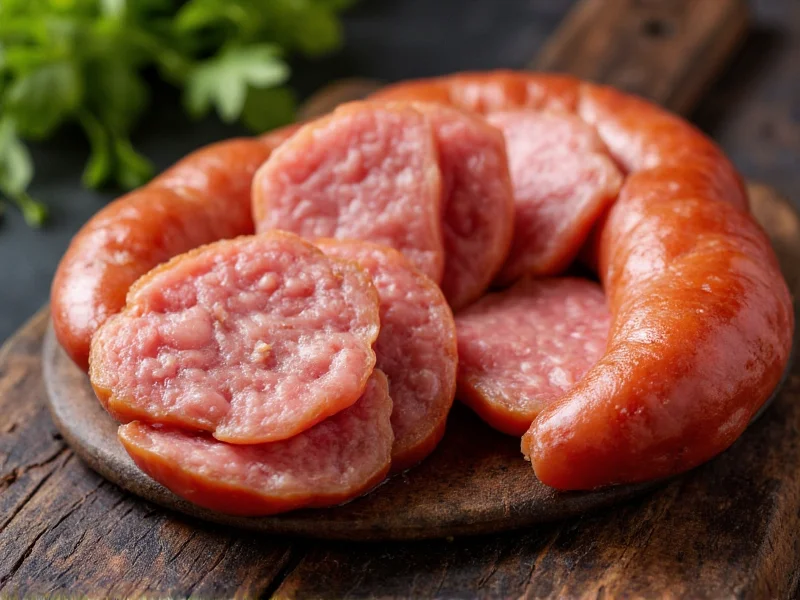Many home cooks and food enthusiasts search for “Parma sausage” expecting a specific Italian sausage product, but this reflects a widespread confusion between Parma ham (prosciutto di Parma) and sausage varieties. Understanding this distinction is essential for authentic Italian cooking and proper ingredient selection.
Why the Parma Sausage Misconception Exists
The confusion typically stems from Parma's global fame for prosciutto di Parma, a prized cured ham with Protected Designation of Origin (PDO) status. When people hear “Parma,” they associate it with Italian cured meats but mistakenly apply it to sausages. In reality, Parma is in Italy's Emilia-Romagna region, which produces various traditional sausages, but none are officially called “Parma sausage.”
Prosciutto di Parma: What People Often Mistake for Sausage
Prosciutto di Parma is a dry-cured, unsmoked ham aged for at least 12 months. Unlike sausages, which contain ground meat stuffed into casings, prosciutto is made from whole pork legs cured with sea salt. The PDO certification ensures only hams produced in designated areas of Parma following strict protocols can bear this name.
| Characteristic | Prosciutto di Parma | Traditional Italian Sausage |
|---|---|---|
| Meat Cut | Whole pork leg | Ground pork (typically shoulder) |
| Preparation | Dry-cured, aged 12+ months | Fresh or cured, stuffed in casings |
| Texture | Delicate, paper-thin slices | Firm, crumbly when cooked |
| Cooking Required | No (eaten raw) | Yes (typically) |
| PDO Status | Yes (strict regulations) | Varies by regional variety |
Traditional Sausages from Emilia-Romagna Region
While Parma itself doesn't produce a signature “sausage,” the surrounding Emilia-Romagna region features several notable varieties that might interest those searching for Parma sausage alternatives:
- Zampone – A hollowed pig's trotter stuffed with spiced ground pork, traditionally served during holidays
- Cotechino – A fresh pork sausage with peppercorns and nutmeg, often served with lentils
- Salsiccia fresca – Fresh, uncooked pork sausage with fennel seeds, commonly used in regional pasta dishes
- Soppressata – A cured, dried sausage with coarsely ground meat, varying by sub-region
Culinary Applications: Using Prosciutto Instead of Sausage
When recipes call for “Parma sausage” or when home cooks want to substitute prosciutto for sausage, consider these authentic applications:
Prosciutto di Parma works exceptionally well in dishes where you'd typically use cooked sausage for flavor enhancement. Chefs often incorporate thin strips into pasta fillings, wrap it around meats for added moisture, or use small pieces to flavor bean soups. Unlike sausage, prosciutto doesn't require cooking and melts into dishes during preparation, creating a rich umami base without the need for additional salt.
For those seeking traditional Italian sausage recipes from the Parma area, look for salsiccia alla parmigiana which features coarsely ground pork with black pepper and wine, reflecting local culinary traditions of the Emilia-Romagna region.
How to Select Authentic Products
When shopping for genuine Parma products, look for specific indicators:
- Prosciutto di Parma should display the five-point crown logo and have a certification number
- Traditional sausages will specify their regional origin (e.g., “prodotto tipico dell'Emilia-Romagna”)
- Avoid products labeled “Parma sausage” as these are marketing terms without PDO protection
- Quality Italian sausages contain only pork, salt, pepper, and regional spices—no fillers
Understanding the difference between prosciutto di Parma and regional sausages helps prevent culinary mistakes and ensures authentic Italian cooking experiences. Whether you're searching for traditional Italian sausages from Parma region or learning how to use prosciutto instead of sausage in recipes, recognizing these distinctions elevates your cooking accuracy and appreciation for Italian culinary traditions.
Frequently Asked Questions
Is Parma sausage the same as prosciutto di Parma?
No, Parma sausage doesn't exist as an authentic product. Prosciutto di Parma is a protected PDO cured ham from Parma, Italy, while sausage products from the region have different names and preparation methods. The confusion arises because Parma is famous for its ham, not a specific sausage variety.
What's the closest sausage to use when a recipe mentions Parma sausage?
If a recipe mentions “Parma sausage,” it likely intends prosciutto di Parma for flavoring. For actual sausage, use salsiccia fresca (fresh Italian sausage) with fennel seeds, which is common throughout Emilia-Romagna. Alternatively, pancetta can provide similar salty richness when diced small.
Can I substitute prosciutto for sausage in recipes?
Yes, but with adjustments. Prosciutto works well as a flavor enhancer in dishes like pasta sauces, bean soups, or wrapped around meats. Since prosciutto is saltier and doesn't require cooking, use about half the amount you would for sausage. It won't provide the same texture as cooked sausage crumbles but adds exceptional umami depth.
What traditional sausages come from the Parma region?
The Emilia-Romagna region around Parma produces several traditional sausages including salsiccia fresca (fresh pork sausage with fennel), zampone (stuffed pig's trotter), and cotechino (spiced fresh sausage). None are officially called “Parma sausage,” but these represent authentic regional products you might find in Parma's markets.
How can I identify authentic prosciutto di Parma versus imitations?
Authentic prosciutto di Parma displays the official five-point crown logo, has a certification number, and is produced only in designated areas of Parma province. The meat should be deep rose-colored with marbled fat, flexible when rolled, and have a sweet, nutty aroma. Avoid products labeled “Parma style” or “Parma sausage,” as these are not protected PDO products.











 浙公网安备
33010002000092号
浙公网安备
33010002000092号 浙B2-20120091-4
浙B2-20120091-4